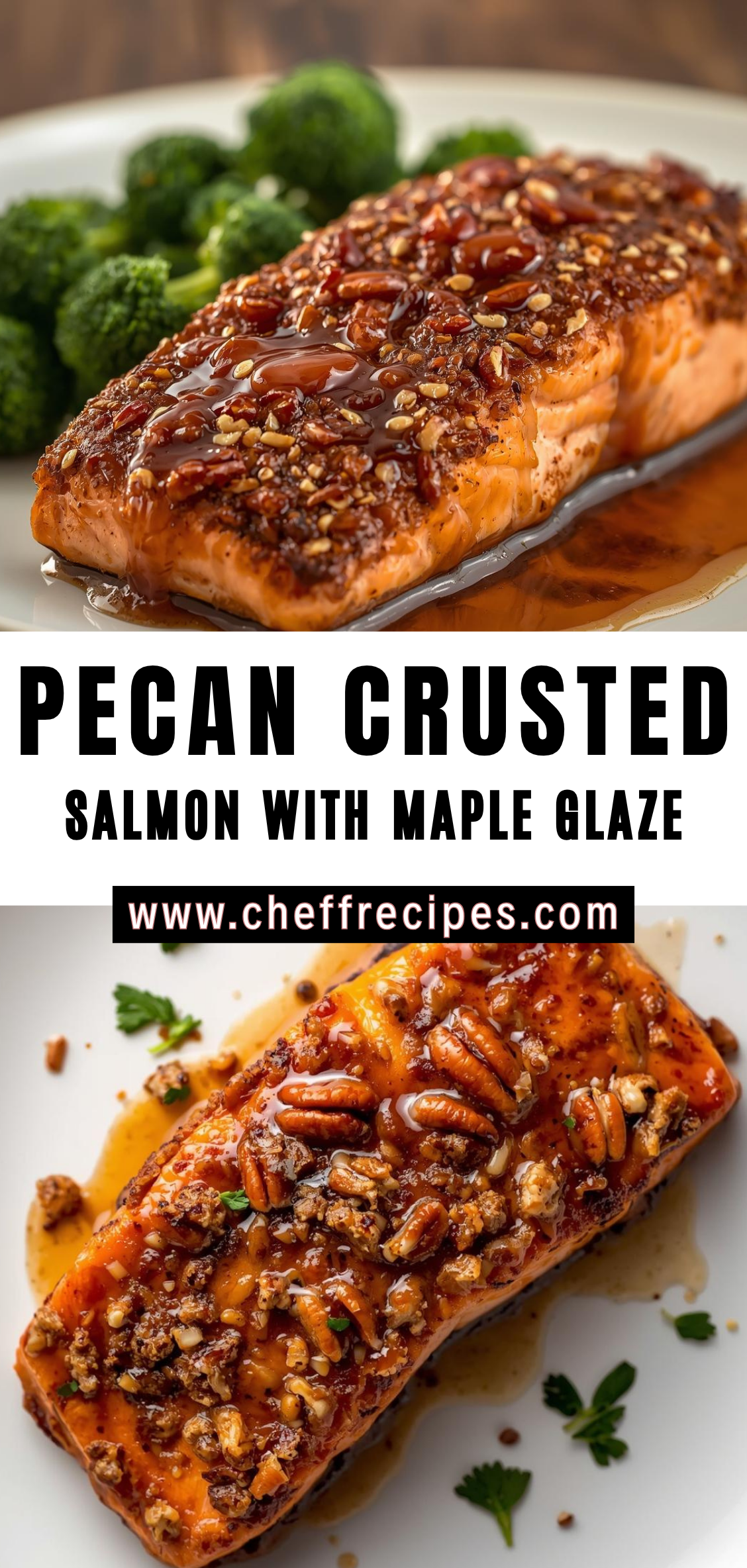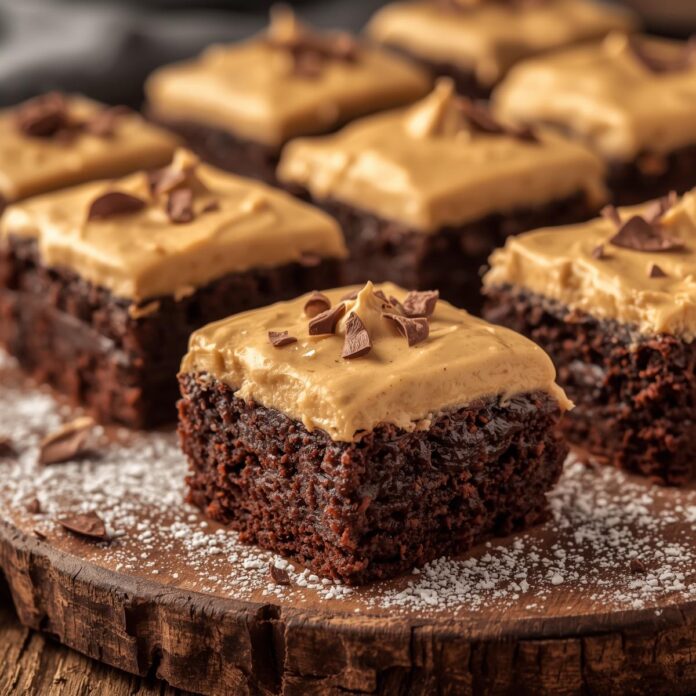There are few dishes that manage to balance indulgence and elegance as gracefully as Pecan Crusted Salmon with Maple Glaze. It is a recipe that speaks to both the rustic heart of Southern cuisine and the refined simplicity of modern dining. The contrast of textures and flavors—crisp, buttery pecans giving way to the tender, silky flesh of salmon, all enrobed in a caramelized sheen of pure maple syrup—creates a culinary harmony that feels both comforting and sophisticated. Every element in this dish has a purpose: the richness of the fish, the earthy sweetness of the glaze, the nutty crunch of the crust, and the subtle tang of seasoning that ties everything together.

In the world of contemporary home cooking, salmon has become a canvas for creativity. Its naturally high fat content allows it to withstand a range of cooking methods—from pan searing and baking to grilling and poaching—without losing its characteristic succulence. Yet, in this recipe, it is not just a vehicle for flavor; it is the star. The pecan crust provides contrast and structure, while the maple glaze infuses depth and warmth, elevating the salmon into a centerpiece worthy of both weeknight dinners and holiday gatherings.
The roots of this dish are steeped in regional tradition. Pecans, indigenous to North America and cultivated most abundantly in the Southern United States, have long been a hallmark of Southern cooking. They lend a distinctive buttery flavor and subtle sweetness that pair remarkably well with seafood. Maple syrup, on the other hand, draws its heritage from the northern forests of the United States and Canada, where it has been harvested for centuries as a natural sweetener with complex flavor undertones—smoky, woody, and gently caramelized. When these two ingredients come together, they form a bridge between culinary regions and histories: the nut-rich warmth of the South meets the amber sweetness of the North, brought together through the unifying richness of fresh salmon.
Pecan Crusted Salmon with Maple Glaze is more than the sum of its parts. It represents an intersection of texture and flavor, of tradition and innovation, of simplicity and finesse. The dish can be executed in under thirty minutes, yet its taste suggests far more effort and artistry. The glaze alone can be adjusted to taste—made sweeter with extra maple syrup, more savory with Dijon mustard, or more complex with a touch of soy sauce or bourbon. The crust, too, invites experimentation, from finely ground pecans for a uniform, delicate coating to coarser pieces for a rustic, hearty crunch.
What makes this recipe particularly appealing is its versatility. It can be prepared for an intimate dinner for two or scaled up to serve a crowd without losing its charm. It complements a wide range of sides—from creamy mashed sweet potatoes and roasted Brussels sprouts to citrus-infused couscous or a simple arugula salad dressed with lemon vinaigrette. The balance of sweet and savory allows it to fit seamlessly into various culinary contexts, whether served alongside classic Southern fare or as part of a modern, minimalist menu.
Beyond its flavor, the dish also offers notable nutritional benefits. Salmon is an excellent source of omega-3 fatty acids, high-quality protein, and essential vitamins such as B12 and D. Pecans contribute healthy fats, antioxidants, and minerals, while pure maple syrup—when used in moderation—provides a natural, unrefined sweetness that stands in stark contrast to processed sugars. This alignment of indulgence with nutrition makes the meal satisfying on multiple levels: it nourishes the body while also pleasing the senses.
At its heart, Pecan Crusted Salmon with Maple Glaze is about balance—between richness and restraint, sweetness and savoriness, tradition and innovation. It invites both novice cooks and experienced chefs to explore flavor through texture, to discover how a few thoughtfully chosen ingredients can create a dish that feels timeless yet contemporary. Whether served on a quiet evening at home or as the focal point of a celebratory dinner, it leaves an impression not only through taste but through its story: a tale of heritage, craftsmanship, and the simple joy of bringing wholesome ingredients together in harmony.
Instructions: The Art of Preparing Pecan Crusted Salmon with Maple Glaze
The success of Pecan Crusted Salmon with Maple Glaze lies not only in the ingredients themselves but in the care with which each stage of the preparation is handled. From selecting the salmon fillets to toasting the pecans, every step builds upon the next, contributing layers of texture, flavor, and aroma that culminate in a dish of remarkable depth. Below is a comprehensive, methodical guide to creating the perfect balance between crispness and tenderness, sweetness and savoriness.
Step 1: Selecting and Preparing the Salmon
Begin by choosing high-quality salmon fillets. Ideally, opt for fresh, wild-caught salmon when available—species such as King (Chinook), Sockeye, or Coho offer exceptional flavor and texture. Farmed salmon can also be used, but look for sustainably raised varieties. The fillets should be approximately 6 to 8 ounces each, with the skin removed for even coating. If the skin is left on, it can add an extra layer of flavor and protection during baking, but the pecan crust will adhere more evenly to a skinless surface.
Rinse the fillets gently under cool water and pat them dry thoroughly with paper towels. Moisture is the enemy of a good crust; excess water prevents the coating from adhering properly and can cause steaming instead of crisping in the oven. Once dry, place the fillets on a clean surface or tray, and inspect for pin bones—use tweezers or needle-nose pliers to remove any that remain. Season lightly with salt and freshly ground black pepper to enhance the natural flavor of the salmon before coating.
Step 2: Preparing the Pecan Crust
The crust is what gives this dish its signature character. Begin with one cup of fresh pecan halves. Toasting the nuts before chopping intensifies their flavor and brings out their oils, creating a deeper, more aromatic foundation for the crust.
To toast, preheat a dry skillet over medium heat. Add the pecans in a single layer and stir or shake gently for three to five minutes, until they become fragrant and slightly darker in color. Take care not to over-toast; pecans can burn quickly, developing a bitter taste that will affect the balance of the dish. Once toasted, transfer them to a plate to cool for a few minutes.
When the pecans are cool enough to handle, chop them finely using a sharp knife or pulse them in a food processor. Avoid over-processing—pecans should retain some texture rather than becoming a paste. Mix the chopped nuts with a small amount of panko breadcrumbs for additional crunch and to help the crust adhere evenly. For a typical batch, use about three-quarters cup of chopped pecans to one-quarter cup of panko. Stir in a teaspoon of finely chopped fresh herbs such as thyme or parsley, and add a pinch of salt to balance the sweetness that will come later from the glaze.
Step 3: Creating the Maple Glaze
The glaze is the heart of the dish, tying together all other flavors. In a small saucepan, combine the following:
-
¼ cup pure maple syrup
-
1 tablespoon Dijon mustard
-
1 tablespoon melted unsalted butter
-
1 teaspoon apple cider vinegar or lemon juice
-
A pinch of cayenne pepper or smoked paprika (optional, for mild heat and depth)
Set the saucepan over low heat and stir gently until the mixture is smooth and glossy. The butter enriches the glaze, while the mustard introduces subtle acidity and sharpness that counterbalance the sweetness of the maple syrup. Simmer briefly—just long enough to meld the ingredients without reducing the liquid significantly. Once finished, remove from heat and allow the glaze to cool slightly; it should thicken just enough to cling to the salmon without running off completely.
Step 4: Coating the Salmon
Preheat the oven to 400°F (200°C). Line a baking sheet with parchment paper or lightly grease it with oil to prevent sticking.
Using a pastry brush or spoon, spread a thin layer of the maple glaze over the top surface of each salmon fillet. This layer serves as both flavor and adhesive for the nut crust. Press a generous handful of the pecan mixture onto each fillet, ensuring full coverage. Apply gentle, even pressure so that the crust adheres but does not crumble. Drizzle or brush a small additional amount of glaze over the top of the pecans to help them caramelize in the oven.
At this stage, you should see the contrast of textures and colors: the pale salmon beneath, the golden flecks of pecans and breadcrumbs above, and a sheen of amber glaze binding everything together. The dish is now ready for baking.
Step 5: Baking the Salmon
Transfer the baking sheet to the preheated oven and cook for 12 to 15 minutes, depending on the thickness of the fillets. For best results, avoid overbaking—the salmon should remain moist and tender at the center. A digital thermometer inserted into the thickest part should register around 125°F (52°C) for medium doneness; if you prefer a firmer texture, cook to 130–135°F (54–57°C).
During the final few minutes of baking, the maple glaze will begin to caramelize, and the pecans will darken slightly, forming a crisp, golden-brown crust. If desired, you can switch the oven to broil for 1–2 minutes at the end of cooking to achieve a more pronounced crunch and a glossy finish. Keep a close eye to prevent burning.
Remove the baking sheet from the oven and allow the fillets to rest for about three minutes before serving. This brief rest allows the juices to redistribute and the crust to set.
Step 6: Serving and Presentation
The beauty of Pecan Crusted Salmon with Maple Glaze lies not only in taste but in presentation. Serve each fillet atop a warm plate, perhaps with a light drizzle of the remaining glaze for added sheen. For garnish, a sprinkle of finely chopped parsley or a few microgreens adds freshness and color contrast. A wedge of lemon on the side offers an optional touch of brightness.
Ideal accompaniments include roasted vegetables—particularly carrots, Brussels sprouts, or sweet potatoes—whose natural sweetness harmonizes with the maple glaze. For a lighter option, pair the salmon with a crisp salad of baby greens dressed in citrus vinaigrette, or serve it over a bed of wild rice or quinoa for a heartier meal. The balance between textures—the crunchy crust, tender salmon, and smooth sides—creates a symphony of sensations in every bite.
Step 7: Final Touches and Adjustments
Cooks who wish to personalize the dish can adjust the glaze and crust to their preference. For a more pronounced sweetness, increase the maple syrup slightly or use Grade A Dark Amber syrup, which has a richer, more robust flavor. To add complexity, incorporate a teaspoon of soy sauce, bourbon, or whole-grain mustard into the glaze. Those who prefer a lighter, more herbaceous crust may add crushed rosemary or a hint of citrus zest to the pecan mixture.
If preparing for guests, the salmon can be crusted and glazed in advance, then refrigerated for up to two hours before baking. This makes it a convenient choice for entertaining, as it allows the cook to focus on side dishes or final plating while the oven handles the main course.
Pecan Crusted Salmon with Maple Glaze rewards patience and attention to detail. Each stage—drying the fillets, toasting the pecans, blending the glaze—builds toward a harmony of flavor and texture that feels greater than its simplicity suggests. When executed properly, the result is a dish that embodies warmth, craftsmanship, and balance, appealing to the eye, the palate, and the heart alike.
Pecan Crusted Salmon with Maple Glaze Recipe
There are few dishes that manage to balance indulgence and elegance as gracefully as Pecan Crusted Salmon with Maple Glaze. It is a recipe that speaks to both the rustic heart of Southern cuisine and the refined simplicity of modern dining. The contrast of textures and flavors—crisp, buttery pecans giving way to the tender, silky flesh of salmon, all enrobed in a caramelized sheen of pure maple syrup—creates a culinary harmony that feels both comforting and sophisticated. Every element in this dish has a purpose: the richness of the fish, the earthy sweetness of the glaze, the nutty crunch of the crust, and the subtle tang of seasoning that ties everything together.
Ingredients
- For the Salmon:
- 4 (6 oz) salmon fillets, skin on or off
- Salt and black pepper, to taste
- 1 tablespoon Dijon mustard
- 2 tablespoons pure maple syrup
- 1 tablespoon melted butter
- 1 teaspoon soy sauce (optional, for added depth)
- For the Pecan Crust:
- 1 cup finely chopped pecans
- ¼ cup panko breadcrumbs (or crushed crackers, optional for extra crunch)
- 1 tablespoon brown sugar (light or dark)
- ½ teaspoon smoked paprika (optional)
- ¼ teaspoon salt
Instructions
Notes
- Fish doneness: Internal temperature should reach 145°F (63°C) at the thickest part.
- Pecans: Toast them lightly before chopping for deeper flavor.
- Make it gluten-free: Omit panko or use gluten-free breadcrumbs.
- Variation: Substitute salmon with trout, cod, or chicken breasts (adjust cooking time accordingly).



